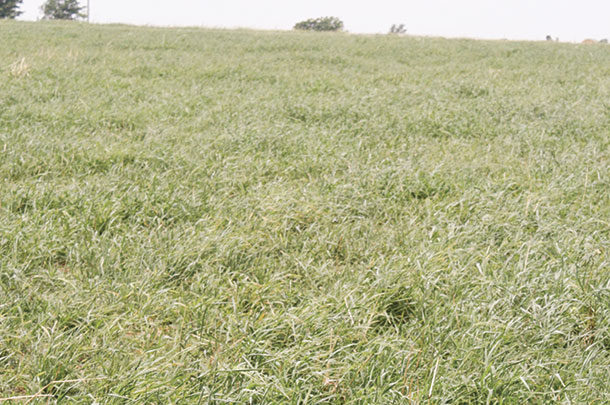Management decisions such as spanning soil fertility economics, market risk management and selecting adapted breeding stock and forages can have wide-reaching impact on the resilience of a farm business. The 2020 Fall Kentucky Forage and Grassland Council Grazing Conference addressed the topic of how to design resilient forage-livestock grazing systems, particularly in the transition zone of the U.S.
Beneath the surface
Down to the fundamentals, Jimmy Henning, extension professor at the University of Kentucky, discussed how to manage soil fertility in uncertain times.
The economic benefits and efficiencies of proper soil fertility management are great. To start, Henning recommended farmers start with the free Web Soil Survey to generate a soil map of their farms, which can open doors to managing better, including using a university publication and the soil types to estimate stocking rate for cool-season pastures in Kentucky.
The next important step is soil testing, which provides a baseline of soil pH, phosphorus and potassium.
“If we’re not testing, we’re just guessing,” Henning said.
He recommended sampling every two to three years at a depth of 3 to 4 inches.
Livestock pasture systems remove relatively small quantities of nutrients since manure cycles many nutrients back to the soil. In contrast, harvesting and selling hay removes far larger quantities.
Forage harvest removes much more potassium than phosphorus – something to pay close attention to when applying fertilizer.
“The ratio of potash-to- phosphorus is 3-to-1 or more,” Henning said.
He showed a study of fertilizer on a low-fertility field with heavy broomsedge weed pressure and low productivity. Proper fertilization, while costing $138 per acre, showed a 2-ton-per-acre yield increase with marked forage quality improvement since the broomsedge practically disappeared, so the fertilizer also provided broomsedge control without losing a year of production that would have resulted by attempting to kill the weed with chemicals or tillage before reseeding a forage mix.
Another way to manage fertility is factoring in the nutrients brought onto the farm by hay purchases. In addition, utilizing managed paddock rotation can help livestock spread manure more evenly over a field instead of overfertilizing watering and shade areas.
Properly managed legumes can offer “free” nitrogen and eliminate the need for purchased nitrogen fertilizer. However, Henning said 30% to 50% of pasture mix by weight needs to be legume to achieve this. There are visual reference guides to help gauge this level.
He explained the current year’s benefit to the grass in the mix was created the year before when the livestock ate the legumes and left the manure in the field for the grass to take up the nutrients.
Optimizing selection
Chris Teutsch, extension associate professor at the University of Kentucky, talked about optimizing existing forage resources by managing diverse mixes for optimum production for the particular need.
Management tactics include adjusting grazing height, frequency and nitrogen fertilizer timing to favor a particular species. For example, Teutsch explained if a farmer has a mix of orchardgrass, tall fescue and bermudagrass and wants more fescue and orchardgrass, leaving more residual and not grazing hard in the summer can encourage the desired species while shading the bermudagrass.
On the flip side, if the strong summer growth of bermudagrass is more desired, grazing the stand more tightly in the summer can discourage the orchardgrass and fescue. Timing of nitrogen fertilizer to the benefit of the desired species can be utilized in addition to grazing for a more powerful effect.
Teutsch emphasized the importance of rotational grazing and that there is no need to make it more complicated than it actually is. He suggested starting out with just three or four paddocks to start to see a benefit and improve over time. It is hard to find one management change that comes with a 30% increase in productivity. Teutsch said the system should be constantly adapted and refined as time goes on.
He also discussed the law of the minimum: finding what plant growth factors are limiting production and correcting them if possible, especially with plant nutrients. Optimizing the farm’s solar panel of forage species with proper management and utilizing improved forage varieties for best performance is key.
The key takeaway was matching forages to their ideal environment for best production. For example, placing red clover in wetter places and using alfalfa for high-production systems with carefully catered management.
Grazing management
Johnny R. Rogers, a North Carolina producer and Amazing Grazing coordinator at North Carolina State University, addressed selecting and managing livestock for a changing environment.
Being well adapted to volatile conditions like weather and markets is vital for the animals and the farmer. Rogers suggested managing market risk by keeping more than one species. He currently runs a beef herd as well as a sheep flock.
For trait selection, Rogers emphasized the importance of using expected progeny differences (EPDs) to select for efficiency and functionality with traits like longevity, moderate size and calving ease. Using crossbreeding is “the only free lunch for stock breeders,” he said.
He added that studies have shown the older suggestions of raising beef heifers to 65% of adult weight seem to be unnecessary and counterproductive. He suggested 55% of adult weight is a better target for more efficient economics. Beef replacements also perform better in the long term if raised on pasture compared to on a feedlot.
He emphasized the importance of having livestock adapted to the farm. Selecting breeding stock from farms with similar or worse management can further this goal.
“Rockets run on rocket fuel,” he said.
It is important to match stock’s genetic potential with the production environment on the farm for best results. In a lower-input grazing system, moderate-sized cattle with selection for fertility and longevity can shine.
“I think that needs to be the focus of every grazier,” he said.









